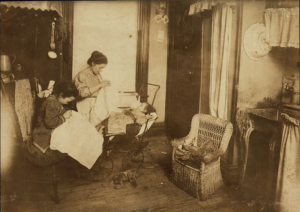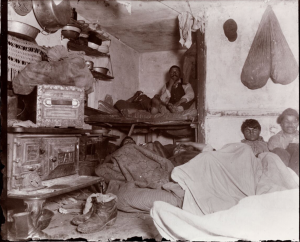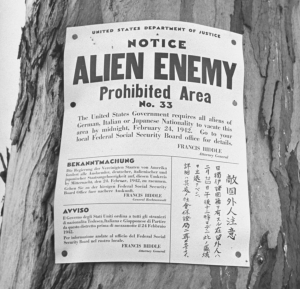“309 W. 146th Street. […] and her seven year old daughter, Lorenza, embroidering ladies waists in their dirty kitchen-living room. Lorenza makes the stems of the flowers. Her mother said, ‘See how smart she is. I show her how and right away she makes them.’ ‘She is so little because she’s been sick so much.[‘] She works after school. Father is out of a job. ‘They pay too cheap for lace.’ Said they make about $2.00 a week. Location: New York, New York”, photo (1912)

The title of this photograph by Lewis Hine pretty much sums up exactly what is going on. It is representative of the kinds of things Italian immigrants had to deal with, mainly in cities and poverty. Work was often scarce and jobs and skilled jobs were not easy to come by. Most of the immigrants from Italy were from the South and were farmers before coming over to the states. The working conditions are notherthing to take note of. They work in their own home, which is dirty and crammed, and make next to nothing for a weeks worth of labor,
Five cents a spot – unauthorized immigration lodgings in a Bayard Street tenement [New York], photo (1890)

The photo above is one in a collection of photographs by a Danish immigrant in New York City published in 1890. The photographs are meant to be seen by the non-immigrant American public as they depict the harsh living, working, and schooling conditions in the tenements that the recent immigrants were put to live in. It is affective in that it is a concrete visual of the tight, dirty, and sometimes unlivable places these immigrants were forced to reside in. The purpose of these photos was to spread awareness to the injustice of the treatment towards the immigrant groups which largely included Italian Immigrants. Riis created an excerpt to go along with the photos that explain his frustration with the United States Government and the wealthier class for allowing this. This extremely accurately depicts the harsh living conditions that some Italian immigrants were struggling to live in as you can see the extreme clutter and lack of sanitation.
Notice Alien Enemy Prohibited Area, poster (notice)(1942)

This is a legal notice that was posted in Terminal Island, California in February of 1942 by the United States Department of Justice. It mandates that all immigrants from Italy, Japan, or Germany must vacate the area of Terminal Island and go to the nearest Social Security Board for relocation. During this time, the US had entered World War 2 against these nations and immigrants of all three nations were often sent to internment camps in fear that they may be spies of the enemies. Italian immigrants, however, were not forced into these camps nearly as much as Japanese imigrants Little to no evidence, however, was ever found against any Italian immigrant in the United States that suggest they were in the US for the purposes of helping Italy in the war. This is an example of something that Italian imigrants had to deal with during the war. Although notices and relocation weren’t very frequent, these types of issues didn’t always exist all over the US.
The Immigration Act of 1924, Act (1924)

The Immigration Act of 1924 was enacted by the US Congress in May of 1924. This Act targeted all immigrant groups around Europe and Asia by prohibiting all Asian immigrants from entering the country and limiting the number of immigrants from European countries by setting quotas for how many immigrants from each country were allowed in the US. The act also allowed for the deportation of any immigrants in the US if their native countries quotas were exceeded. This Act furthered anti-immigration sentiment and impacted the number of Italian immigrants that would come to the US. It was a result of growing anti-immigration sentiment that loomed acrss the United States at the time.
